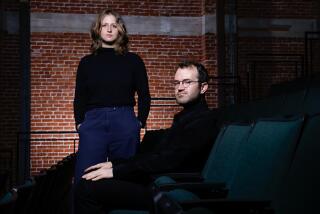Why the Tribeca Film Festival isn’t just about film anymore
For the last 15 years, the Tribeca Film Festival has trafficked in a certain kind of independent cinema. It’s a place where art house hits such as “Transamerica,” “City Island” and “Let the Right One In”” — along with some lesser lights — have made their world premieres.
These types of movies will still very much be on the agenda when the New York gathering cofounded by Robert De Niro kicks off Wednesday. But this year also comes with a different mantra: Explore other forms of content, early and often.
Tribeca has cut down the number of film features by about 20%, to fewer than 100.
At the same time, the Jane Rosenthal-overseen gathering has ramped up its efforts in other areas — with an expanded television program that includes the debuts of Hulu’s “The Handmaid’s Tale” and National Geographic’s “Genius”; a high-impact virtual-reality program that this year features a new movie by Kathryn Bigelow; and an emphasis on music that will yield an opening-night concert featuring Aretha Franklin and Carly Simon.
It’s a film festival, in short, that’s less about the film and more about everything else--raising questions about the very nature and relevance of the modern movie gathering.
“This year we are all stories, all screens,” says Tammie Rosen, executive vice president of communications and programming. “We don’t want to limit anything just because it’s not a film. We don’t want any arbitrary boundaries.”
The shift — subtle in some spots and more pronounced in others — is partly a function of Tribeca’s place on the calendar. As a springtime event, the fest has sometimes struggled to attract high-end world premieres, with Cannes immediately following and, in the months before, Sundance and South by Southwest siphoning other movies.
But the change is also because of programmers’ more fundamental recognition that many consumers — and filmmakers — are now immersed in creations besides the 100-minute feature.
“We truly are format-agnostic and want to follow the creators,” says director of programming Cara Cusumano. “If they’re working in a new medium, we’ll create the space for it.”
We don’t want to limit anything just because it’s not a film. We don’t want any arbitrary boundaries.
— Tammie Rosen, Tribeca Film Festival executive vice president of communications and programming
Tribeca’s virtual-reality and multimedia program, for instance, began in earnest five years ago and has become a go-to place for creators to premiere new work. This year, that will include some veteran VR figures, such as Felix & Paul Studios, bringing “The People’s House,” in which Barack and Michelle Obama walk viewers through the White House. And it will boast some traditional filmmakers making their way into the medium, such as Bigelow’s work with VR vet Imraan Ismail on “The Protectors,” set amid elephant-guarding rangers in the Congo.
TV also is a key growth area. The fest will not only mark the unveiling of “Handmaid’s Tale,” the totalitarian-themed Margaret Atwood adaptation that begins streaming April 26, and “Genius,” the Albert Einstein dramatization starring Geoffrey Rush with the executive-producing imprimatur of Brian Grazer and Ron Howard, but more offbeat projects, such as HBO’s upcoming “Chris Gethard: Career Suicide” special and “The Eyeslicer,” an indie variety show from a range of new voices that, if nothing else, boasts great fest boilerplate. (“The hour-long show will slice, dice and then mince your eyeballs into delicious ceviche.”)
(Many of these series will seek to follow the template of “The Night Of,” the Steven Zaillian and Richard Price crime series that HBO debuted at Tribeca in 2016 to great effect, helping pave the way for its buzzy summertime airing.)
Even material that once might have been the stuff of traditional narrative features is getting a format shakeup. That includes ESPN’s hourlong “Mike and the Mad Dog,” about combustible sports-radio personalities Mike Francesa and Chris Russo, and a prolific shorts slate that features everything from John Turturro’s “Hair,” in which he and Bobby Cannavale discuss a man’s relationship to his follicles, to “Fry Day,” Laura Moss’ teenage girl coming-of-age story in the shadow of Ted Bundy’s execution.
“I do think most of the young filmmakers we meet are longing to make a film at some point — it’s not that they just want to do three-minute online series,” says Paula Weinstein, executive vice president at Tribeca Enterprises. “But many are making a progression from film first to online or to television, and as a festival we want to support them.”
Other fests have of course sought out new mediums. But Tribeca pushes this definition further, with premieres of nearly a dozen digital-only works. Many are, indeed, from unknown first-timers, either working solo or with the likes of CryptTV, Eli Roth’s digital genre label. Others are established types experimenting with new formats, such as with “Aware: A Dream From Standing Rock,” a documentary short series about the Dakota Access Pipeline affair codirected by Oscar nominee Josh Fox. There’s also a new sidebar for gaming and an awards section for “Snapchat Shorts.”
That’s not to say movies won’t seek the elusive Tribeca breakout. Notables include Russell Harbaugh’s “Love After Love,” in which Andie MacDowell plays a woman trying to hold her family together after the death of a patriarch; “Aardvark,” a therapist-centric drama starring and produced by Zachary Quinto; and “The Lovers,” Azazel Jacob’ marital drama starring Debra Winger and Tracy Letts.
In keeping with Tribeca’s focus on colorful personalities, there’s “Dog Years,” a thinly veiled story about the rise and fall of Burt Reynolds, with the mustachioed one in the roman-a-clef role, and “The Clapper,” in which director Dito Montiel has Ed Helms as an unlikely viral-video star in a relationship with Amanda Seyfried--a movie in which Rob Gronkowski, Mark Cuban and Alan Thicke also appear.
On the documentary side, “The Reagan Show” presciently looks at the former president’s use of the television medium. David France’s “The Death and Life of Marsha P. Johnson” is an examination of a transgender icon by the Oscar-nominated director of “How To Survive a Plague” and “AlphaGo” explores the realm of artificial intelligence and board games. And Gilbert Gottfried gets his behind-the-curtain close-up (a quiet family man?) in Neil Berkeley’s “Gilbert. (Not screening will be “No Stone Unturned,” Alex Gibney’s new film about the unsolved murders of half a dozen people in Northern Ireland during the 1994 World Cup that was pulled last week amid threats of legal action.)
For sheer political intrigue, “Get Me Roger Stone” and “The Grey State” — about the Republican operative and the late alt-right cult figure David Crowley, respectively — give the festival a timely feel.
Even so, Tribeca is spotlighting many other forms of content. It is a way for the festival to distinguish itself, to carve out an identity. As these expansions proceed, they also serve as a canary in a coal mine for other festivals. Toronto and Sundance, for instance, have created TV sections but have not been as broad in their non-film efforts. And even the ever-cautious Cannes for the first time this year will feature both TV and VR in its official selection.
One non-film area Tribeca will double down on is high-profile appearances: Johnny Rotten at a screening for “The Public Image Is Rotten,” a doc about him; the Aretha Franklin concert at Radio City Music Hall after the screening of “Clive Davis: The Soundtrack of Our Lives”; Sean Combs performing with Lil’ Kim and Mase in honor of a film about his Bad Boy Records; and a reunion of Francis Ford Coppola and the cast of “The Godfather” and “The Godfather Part II.” In the worlds-colliding department, Robert Rodriguez will hold an onstage talk with...Barbra Streisand.
But film premieres have historically been key to how a festival makes a name for itself. It remains to be seen if that can change, especially at a time when exhibitors and some distributors are wary of veering from the theatrical experience.
For a gathering like Tribeca, which has sometimes struggled to find its niche, the challenge becomes even greater — pushing into new territory risks muddling its identity further.
Festival organizers maintain they are not concerned. There is too much heat in too many new places to worry about labels, they say. If the cutting-edge comes with some confusion, so be it.
“I think it’s as fertile a time in terms of visual storytelling as I’ve seen in my life,” says Weinstein, who ran United Artists and is a longtime producer and veteran of Warner Bros. and 20th Century Fox. “It’s in a way what Hollywood was like in the early days, when everything was possible. We want to take full advantage of that.”
See the most-read stories in Entertainment this hour »
Twitter: @ZeitchikLAT
ALSO
‘Lost City of Z’ actor Charlie Hunnam, reluctant star and existential Hollywood soul
John Legend is singing a new tune: virtual reality
More to Read
Only good movies
Get the Indie Focus newsletter, Mark Olsen's weekly guide to the world of cinema.
You may occasionally receive promotional content from the Los Angeles Times.







